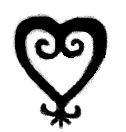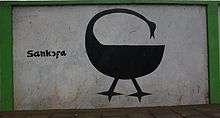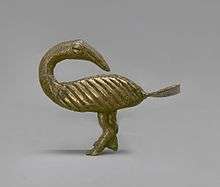Sankofa

Sankofa is a word in the Twi language of Ghana that translates as "Go back and get it" (san - to return; ko - to go; fa - to fetch, to seek and take) and also refers to the Asante Adinkra symbol represented either by a bird with its head turned backwards taking an egg off its back, or as a stylised heart shape. Sankofa is often associated with the proverb, “Se wo were fi na wosankofa a yenkyi," which translates as: "It is not wrong to go back for that which you have forgotten."[1]
The sankofa symbol appears frequently in traditional Akan art, and has also been adopted as an important symbol in an African-American and African Diaspora context to represent the need to reflect on the past to build a successful future. It is one of the most widely dispersed adinkra symbols, appearing in modern jewellery, tattoos, and clothing.

Akan symbolism

The Akan people of Ghana use an Adinkra symbol to represent this same idea and one version of it is similar to the eastern symbol of a heart, and another version is that of a bird with its head turned backwards taking an egg off its back. It symbolizes taking from the past what is good and bringing it into the present in order to make positive progress through the benevolent use of knowledge. Adinkra symbols are used by the Akan people to express proverbs and other philosophical ideas.
The sankofa bird also appears on carved wooden Akan stools,[2] in Akan goldweights, on some ruler's state umbrella or parasol (ntuatire) finials and on the staff finials of some court linguists.[3] It functions to foster mutual respect and unity in tradition.[4]
Use in North America and the United Kingdom
During a building excavation in Lower Manhattan in 1991, a cemetery for free and enslaved Africans was discovered. Over 400 remains were identified, but one coffin in particular stood out. Nailed into its wooden lid were iron tacks, 51 of which formed an enigmatic, heart-shaped design that could be a sankofa symbol.[5][6] The site is now a national monument, known as the African Burial Ground National Monument, administered by the National Park Service. A copy of the design found on the coffin lid is prominently carved onto a large black granite memorial at the center of the site.[7]
The National Museum of African American History and Culture uses the heart-shaped symbol on its website.[8] The "mouse over" for the image reads: "The Sankofa represents the importance of learning from the past."
Sankofa symbols show themselves all over cities like Washington, DC and New Orleans, particularly in fence designs.
Janet Jackson has a sankofa tattoo on her inner right wrist. The symbol is also featured in her 1997 album The Velvet Rope, as well as on the supporting tour.
Sankofa is an event used by Saint Louis University to honor African-American student graduates and students who graduate with degrees in African American studies.
The symbol and name were used in the 1993 film Sankofa by Haile Gerima, as well as in the graphic title of the film 500 Years Later by Owen 'Alik Shahadah.
A UK stage production by Adzido Pan-African Dance Ensemble, scripted by Margaret Busby and premiered in 1999, was entitled Sankofa.[9]
The African-American string band Sankofa Strings, founded in 2005 by Sule Greg C. Wilson, Rhiannon Giddens Laffin, and Dom Flemons, was featured in the 2007 jug band documentary Chasin' Gus' Ghost. The band self-released the CD Colored Aristocracy in 2006. A second iteration of the band Sankofa, with Wilson and Flemons, as well as Ndidi Onukwulu and Allison Russell, released the CD The Uptown Strut in 2012.
Cassandra Wilson recorded the song "Sankofa", which appeared on her 1993 Blue Light 'Til Dawn CD.
Sankofa is the name of a Liverpool band formed in 2010. They have released one single "Siren Song" and a four-track EP that includes "Guttermouth" (both available on vinyl and as a download).
In Duncanville, Texas, there is a business called "Sankofa Arts Lounge".
References
W. Bruce Willis, The Adinkra Dictionary: A visual primer on the language of Adinkra, Pyramid Complex (1998), ISBN 0-9661532-0-0
Notes
- ↑ The Spirituals Project at the University of Denver. "African Tradition, Proverbs, and Sankofa". Archived from the original on 20 April 2011. Retrieved 19 February 2010.
- ↑ An example is shown at conradiator.com
- ↑ An example is shown on the myfundi.co.za page on the gold and proverbs of West Africa
- ↑ fa.indiana.edu site on Akan goldweights
- ↑ Seeman, Erik R. (January 2010). "Reassessing the 'Sankofa Symbol' in New York's African Burial Ground," (PDF). William and Mary Quarterly. 67: 101–22. Retrieved 17 April 2011.
- ↑ Sewell Chan (26 January 2010). "Coffin's Emblem Defies Certainty". The New York Times. Retrieved 19 February 2010.
- ↑ "African Burial Ground National Monument". National Park Servicef. Retrieved 19 February 2010.
- ↑ "National Museum of African American History and Culture". Retrieved 2 March 2010.
- ↑ Mary Brennan, "Rhythms of everyday life", Herald Scotland, 10 February 2000.